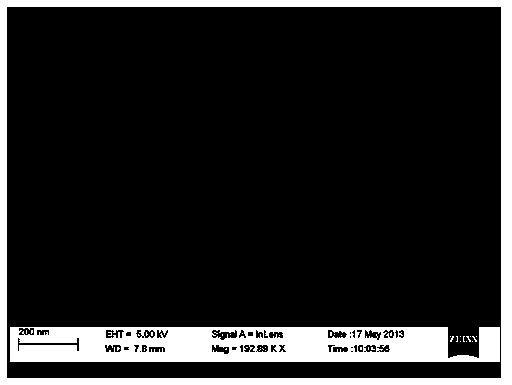Calcium-based carbon dioxide adsorbent and preparation method thereof
A carbon dioxide and adsorbent technology, which is applied in the field of carbon dioxide adsorbent and its preparation, can solve the problems of reducing and increasing absorption costs, and achieve the effects of reducing costs, improving efficiency, high absorption conversion rate and recyclable utilization rate
- Summary
- Abstract
- Description
- Claims
- Application Information
AI Technical Summary
Problems solved by technology
Method used
Image
Examples
example 1
[0028] Example 1: This calcium-based carbon dioxide adsorbent is prepared by the following process.
[0029] (1) At room temperature, add 2g of Tween 80 (English: Tween 80 or Polysorbate 80) and 0.25g of polyethylene glycol (molecular mass: 10,000) into a beaker filled with 200ml of deionized water, and keep a uniform rotation speed of 400rpm Stir for 5 minutes to fully dissolve the solute in the solute. At 30°C, slowly drop 25ml of concentrated sodium carbonate solution (0.1mol / L) into the previous beaker, and then slowly drop 25ml of concentrated calcium chloride solution (0.1mol / L) into the mixed solution. It can be observed that a white precipitate precipitates out, and the stirring is continued for 5 minutes; then the beaker is left to stand at room temperature for 24 hours. In the above process, the weight of the calcium carbonate product in the solution is 0.235g; the mass ratio of the calcium carbonate product to Tween 80 is 1:8.51, and the mass ratio of the calcium c...
example 2
[0033] Example 2: This calcium-based carbon dioxide adsorbent is prepared by the following process.
[0034] (1) At room temperature, add 3g Tween 80 and 0.25g polyethylene glycol (molecular weight 6000) into a beaker filled with 200ml deionized water, keep stirring at a uniform speed of 400rpm for 5 minutes to fully dissolve the solute in in the solute. At 20°C, slowly add 50ml of concentrated sodium carbonate solution (0.05mol / L) into the previous beaker, then slowly drop 50ml of concentrated calcium chloride solution (0.05mol / L) into the mixed solution, at this time It can be observed that a white precipitate precipitates out, and the stirring is continued for 5 minutes; then the beaker is left to stand at room temperature for 20 hours. In the above process, the weight of the calcium carbonate product in the solution is 0.240g; the mass ratio of the calcium carbonate product to Tween 80 is 1:12.5, and the mass ratio of the calcium carbonate product to polyethylene glycol i...
example 3
[0037]Example 3: This calcium-based carbon dioxide adsorbent is prepared by the following process.
[0038] (1) At room temperature, add 3.88g of Tween 80 and 0.25g of polyethylene glycol (molecular mass 8000) into a beaker filled with 200ml of deionized water, and keep stirring at a uniform speed of 400rpm for 5 minutes to fully dissolve the solute in the solute. At 35°C, slowly add 25ml of concentrated sodium carbonate solution (0.1mol / L) into the previous beaker, and then slowly drop 25ml of concentrated calcium chloride solution (0.1mol / L) into the solution. It was observed that a white precipitate was precipitated, and the stirring was continued for 5 minutes; the beaker was left standing at room temperature for 30 hours. In the above process, the weight of the calcium carbonate product in the solution is 0.243g; the mass ratio of the calcium carbonate product to Tween 80 is 1:16, and the mass ratio of the calcium carbonate product to polyethylene glycol is 1:1.03.
[0...
PUM
 Login to View More
Login to View More Abstract
Description
Claims
Application Information
 Login to View More
Login to View More - R&D
- Intellectual Property
- Life Sciences
- Materials
- Tech Scout
- Unparalleled Data Quality
- Higher Quality Content
- 60% Fewer Hallucinations
Browse by: Latest US Patents, China's latest patents, Technical Efficacy Thesaurus, Application Domain, Technology Topic, Popular Technical Reports.
© 2025 PatSnap. All rights reserved.Legal|Privacy policy|Modern Slavery Act Transparency Statement|Sitemap|About US| Contact US: help@patsnap.com



